The first day, March 10, of member previews of the Marina Abromovic retrospective at MoMA, Steve Cannon asked me to take him up there to say hello to her. He remembered interviewing her by email eight years ago when she spent 6 weeks living in three exposed, spartan rooms at Sean Kelly gallery for House with an Ocean View. In "The Artist Is Present", on MoMA's second floor, he understood she would be present, and therefore wanted to present himself to her and mention he'd interviewed her.
"The Artist Is Present" consists of Marina sitting at a table, for three months of MoMA open hours, in the middle of a large open space under massive lights from four corners. Museum attendees are invited to individually sit across from her. She does not speak. She barely emotes. She sometimes rests and shifts when she needs to.
When we got there, there was a line to sit with the artist. We didn't notice the line, and when the middle-aged tourist who had been placidly staring Marina down got up, I tried to guide Steve out there. Naturally the next person in line moved faster and we retreated. It would have been very curious to have heard and seen Steve trying to engage the Present Marina: the perfect communication of the blind with the mute.
The power of many of her works does derive from her visual impact as a tall, very striking, seemingly ageless woman, and the long dress she wears during The Artist Is Present emphasizes that. Yet performance art is a field whose aesthetics derive very little from visuality itself and can primarily consist of description. Some of Marina's best works are rejected proposals. Many are explicitly self-destructive or masochistic to the point of the audience having to call 911 to revive the artist. The best, indeed, rely on trust games with the audience. Documentation is the form in which performance art becomes present and possessable by museums. This means it's more perceptible to the blind than almost anything else that has grown from the Visual Art field (touchable sculptures and sound installations still cling to a certain visual-spatial approach), at the expense of reliance on the verbal.
The rest of the retrospective fills the sixth floor. MoMA makes a point of announcing that this is their first performance art retrospective. It's also a great deal of attention given to a female artist, one who is, as she puts it, the "grandmother" of performance art. In the seventies her work was done in collaboration with German partner Ulay, and the documentation makes it seem that she was the more passionate and dedicated to the interventions they staged, higher profile, the brains of the operation. My favorites are those done with no props, or few, like AAA AAA AAAA (in which they scream louder and louder at each other) or one in which they slap each other. Perhaps the best-known is "Rest Energy"(video), consisting of Marina holding a bow with Ulay holding an arrow cocked in it towards her heart. The best of these were videos - only the less dangerous are reperformed in the retrospective, prompting accusations of a declawing by historical institution. Marina and Ulay's relationship was their work and vice versa, and their collaboration ended through hiking along the Great Wall of China towards each other and then separating. In her maturity, Marina's performances and films tap her Slavic roots and often include dedications and reperformances of other artists' work.
Marina's own work is reperformed in shifts by an army of the body-aware. One of the best is that in which she and Ulay stood naked in a narrow doorway facing each other, while everyone who entered the gallery pushed past them. In the reperformance the gap between them was made large enough to pass by without turning sideways, which Marina was uncomfortable about, but arguably the average body passing through in 2000s America is larger than that in 1970s Europe - a suggestion that, when I brought it up, was considered a bit taboo. When Steve passed through between his two dates, we suggested he face the woman and we the man. He gently stepped on the man's feet and rubbed noses with the woman. The most interesting part of this was peoples' expressions as they came through. A camera crew shooting a feature film documentary on Marina noticed us, and later interviewed Steve and the female performer about experiencing art after losing his sight. "Do you smell them?" were among the stranger questions. My co-date Hilary Maslon answered: "He smokes, he can't smell anything."
In his usual humor, Steve claims that he writes about art easily by just saying what the artist says. One element of this show was that the art itself could potentially react to how I was describing it - although the performative discipline is not to do so.
The performer enjoyed, as I would too, the occasional jostling and scratches that provided some relief from standing in one place for two hours or more. After all, when you've set yourself up to break down your physical boundaries with strangers, violation is the best possible thing that could happen, and yet distance reasserts itself as it must. The prescriptiveness of the verbal documentation and proposals convey far better than any warm analysis the numinosity, zen or shamanistic qualities of Marina's art.
Tuesday, March 23, 2010
Tuesday, March 09, 2010
Art Week Dessert and Snacks
Sunday was to be the day I caught up with the last few shows. What I missed, in order of regretting missing it:
INDEPENDENT (in the X Project / former D.I.A. building)(Art Fag City comments)
The Art Show
PooL
Volta
Red Dot, Korean, some panel on art blogging, wev.
Fountain was like a sideshow consisting of all the desperate, sad parts of the art world that all artists should be warned is what they may look like. I don't think it was just the old dock it was in. Even the few things I saw there that I liked look embarassing in retrospect.
So I ended up in #class, an experimental project by Jen Dalton and Bill Powhida at Winkleman Gallery. It's ongoing with seminars proposed by various artists for the next few weeks and I highly recommend going there. It is fun. It is said that the classroom, particularly in teaching art, is a utopian assertion, and yes, I have a bit of an academic fetish, but this is mine. Dalton and Powhida have already captured my cynic's heart, their institutional critique / Marxy-Feministy drawings (where drawings mean mostly-penciled rants, lists, and charts), seperately, are especially refreshing amongst the art fairs. This kind of inside joke doesn't work without placing itself inside its butt. If all art was like this we'd get tired of it. But still.

There was a truly involving conversation on art, school, and economics on the green board walls in chalk that made me wish I could remember more of the smart things I've said, and also that I could be in school forever (but also remember I shouldn't teach). Drawings are on silent auction and bidding involves an application form.
I gave a hasty interview to "social media expert"/attention economist and former finance guy Zac Cohen. We happened by during Open Gaming, and I ended up sucking at Catan with Jen Dalton's husband and friends. Everyone's kids were there. Bill showed up midway through with some story about leaving a laptop at a strip club. It was one of the happiest hours of my life. I don't think I could have gorged on any more fairs.
I'm made nervous that everyone else has better day jobs.
INDEPENDENT (in the X Project / former D.I.A. building)(Art Fag City comments)
The Art Show
PooL
Volta
Red Dot, Korean, some panel on art blogging, wev.
Fountain was like a sideshow consisting of all the desperate, sad parts of the art world that all artists should be warned is what they may look like. I don't think it was just the old dock it was in. Even the few things I saw there that I liked look embarassing in retrospect.
So I ended up in #class, an experimental project by Jen Dalton and Bill Powhida at Winkleman Gallery. It's ongoing with seminars proposed by various artists for the next few weeks and I highly recommend going there. It is fun. It is said that the classroom, particularly in teaching art, is a utopian assertion, and yes, I have a bit of an academic fetish, but this is mine. Dalton and Powhida have already captured my cynic's heart, their institutional critique / Marxy-Feministy drawings (where drawings mean mostly-penciled rants, lists, and charts), seperately, are especially refreshing amongst the art fairs. This kind of inside joke doesn't work without placing itself inside its butt. If all art was like this we'd get tired of it. But still.

There was a truly involving conversation on art, school, and economics on the green board walls in chalk that made me wish I could remember more of the smart things I've said, and also that I could be in school forever (but also remember I shouldn't teach). Drawings are on silent auction and bidding involves an application form.
I gave a hasty interview to "social media expert"/attention economist and former finance guy Zac Cohen. We happened by during Open Gaming, and I ended up sucking at Catan with Jen Dalton's husband and friends. Everyone's kids were there. Bill showed up midway through with some story about leaving a laptop at a strip club. It was one of the happiest hours of my life. I don't think I could have gorged on any more fairs.
I'm made nervous that everyone else has better day jobs.
Monday, March 08, 2010
Pulse
Rumor is this is the best fair. It was probably worth ditching both works.

Bill Smith Magnetically stabilized, air driven, computer interfaced, chaotic emu egg pendulum, 2010. Water, vacuum formed poly carbonate, carbon graphite rod, aluminum, stainless steel, brass, wood, clay, one emu egg, pumps.
Another reason to love PPOW. They just seem to show good artists. Bill was there and very nice, very able to deal with my chaotic conversation.

Erik Thor Sandberg at Conner Contemporary.
I think what people mean about Pulse being good is that, to be cliche, it has a large proportion of art that speaks for itself.
Here's what I came for, at the invite of the superhumanly gregarious Charlie James, who runs a damn fine gallery in L.A.'s Chinatown.

William Powhida and Jade Townsend, ABMB Shantytown, 2010, 40x60 graphite on paper
Bill Powhida is art's snarky political cartoonist. He'll probably unseat and replace Koons (unless we're really post-Oedipal, and I don't think so). He's been working incredibly hard this year, and I don't know why he's not the only art anyone buys. More on this when I get to the weekend's dessert, #class - its strength is that it's such a relief from all the other stuff, especially the less thorough institutional critique.
Detail: "Have you seen all these grad students coming out of this giant fucking hole?"
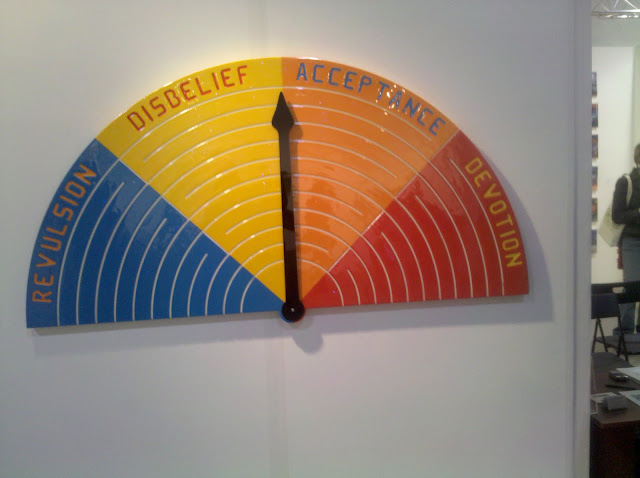
Walter Robinson, Safe, 2009, mixed media

ALICIA ROSS. Motherboard_7 (Sacred_Profane), cross-stitch on cotton & pearled needles, 40 x 90 in, 2008
Thank you, Black and White gallery, for either reminding me or introducing me to one of those artists that makes me envious. My mission has already been fulfilled.

Shane Hope, atom_name_wildcard, 2009. These prints are made from images generated using ridiculously complicated 3-d visualization software that uses biological data. Shane Hope is a posthuman from the current future. I'd already seen his stuff because Winkleman is hosting dessert.

Who did the hypervirtual photo that's on the cover of Lethem's Chronic City? Scott Peterman, that's who.
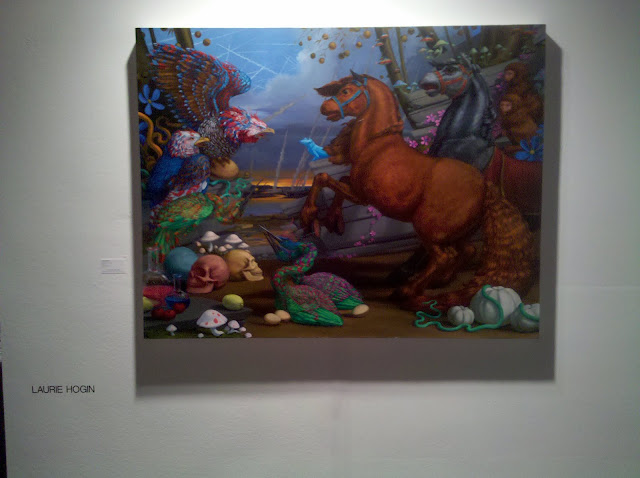
Laurie Hogan, Myth and Empire, oil on canvas, 2010, 48"x60" (Koplin Del Rio in L.A.)
The End.
(or is it...?)

Bill Smith Magnetically stabilized, air driven, computer interfaced, chaotic emu egg pendulum, 2010. Water, vacuum formed poly carbonate, carbon graphite rod, aluminum, stainless steel, brass, wood, clay, one emu egg, pumps.
Another reason to love PPOW. They just seem to show good artists. Bill was there and very nice, very able to deal with my chaotic conversation.

Erik Thor Sandberg at Conner Contemporary.
I think what people mean about Pulse being good is that, to be cliche, it has a large proportion of art that speaks for itself.
Here's what I came for, at the invite of the superhumanly gregarious Charlie James, who runs a damn fine gallery in L.A.'s Chinatown.

William Powhida and Jade Townsend, ABMB Shantytown, 2010, 40x60 graphite on paper
Bill Powhida is art's snarky political cartoonist. He'll probably unseat and replace Koons (unless we're really post-Oedipal, and I don't think so). He's been working incredibly hard this year, and I don't know why he's not the only art anyone buys. More on this when I get to the weekend's dessert, #class - its strength is that it's such a relief from all the other stuff, especially the less thorough institutional critique.
Detail: "Have you seen all these grad students coming out of this giant fucking hole?"

Walter Robinson, Safe, 2009, mixed media

ALICIA ROSS. Motherboard_7 (Sacred_Profane), cross-stitch on cotton & pearled needles, 40 x 90 in, 2008
Thank you, Black and White gallery, for either reminding me or introducing me to one of those artists that makes me envious. My mission has already been fulfilled.

Shane Hope, atom_name_wildcard, 2009. These prints are made from images generated using ridiculously complicated 3-d visualization software that uses biological data. Shane Hope is a posthuman from the current future. I'd already seen his stuff because Winkleman is hosting dessert.

Who did the hypervirtual photo that's on the cover of Lethem's Chronic City? Scott Peterman, that's who.

Laurie Hogan, Myth and Empire, oil on canvas, 2010, 48"x60" (Koplin Del Rio in L.A.)
The End.
(or is it...?)
Verge
So the weekend got so busy I haven't been updating much. We will catch up today.
A quick overview of Verge: it's young and cheap and unlikely to rise to the prominence of the one-word fairs it tries desperately to emulate. Its problems are exacerbated by being held in a midtown hotel, which does not exactly have the best lighting. There are bottlenecks in the doors of the hotel rooms. Rather than adapting to the context and the claims of these smaller fairs to embrace "emerging" and "overlooked" art, this one resembled a particularly cramped craft market.
I left a terrific opening of sculptures by Sudarshan Shetty at Jack Tilton Gallery on the Upper East Side to go to this thing. I probably shouldn't have - Steve needed me and Jack serves food. I was hungry. Verge in the Dylan Hotel was above Benjamin Steak House and the flesh made me crazy.
There seemed to be a lot of little Japanese outfits at Verge. There was at least a comfortable middle-class feel to the thing - watching Alex at Mighty Tanaka made opening a little art-selling business look fun.
Van Uxem projects, at first glance, was a sparse and intimate vanity project, but in retrospect, Heather's was the best use of the hotel setting, and the least commercially desperate. She projected an abstract mouthlike video on a screen beside sex toys coated in wax. On the other side of the screen, of course, she sat exhausted while her son tried to sleep and strangers walked through looking uncomfortable.
Whereas Rebecca Leyche's Vagina Doorknobs (exactly what they sound like) were slightly deflated by their sales pitch label.
A quick overview of Verge: it's young and cheap and unlikely to rise to the prominence of the one-word fairs it tries desperately to emulate. Its problems are exacerbated by being held in a midtown hotel, which does not exactly have the best lighting. There are bottlenecks in the doors of the hotel rooms. Rather than adapting to the context and the claims of these smaller fairs to embrace "emerging" and "overlooked" art, this one resembled a particularly cramped craft market.
I left a terrific opening of sculptures by Sudarshan Shetty at Jack Tilton Gallery on the Upper East Side to go to this thing. I probably shouldn't have - Steve needed me and Jack serves food. I was hungry. Verge in the Dylan Hotel was above Benjamin Steak House and the flesh made me crazy.
There seemed to be a lot of little Japanese outfits at Verge. There was at least a comfortable middle-class feel to the thing - watching Alex at Mighty Tanaka made opening a little art-selling business look fun.
Van Uxem projects, at first glance, was a sparse and intimate vanity project, but in retrospect, Heather's was the best use of the hotel setting, and the least commercially desperate. She projected an abstract mouthlike video on a screen beside sex toys coated in wax. On the other side of the screen, of course, she sat exhausted while her son tried to sleep and strangers walked through looking uncomfortable.
Whereas Rebecca Leyche's Vagina Doorknobs (exactly what they sound like) were slightly deflated by their sales pitch label.
Friday, March 05, 2010
SCOPE
I went to their offices first by accident instead of the Lincoln Center tent
It turned out an hour was enough to go through the whole thing, though. The gallerists were friendlier but unlike its Miami incarnation this one did not provide free food and drink. Given the freebie culture of NYC calorie constraint was wise - there probably wouldn't be enough security personnel even with well-behaved informed crowds.
That's part of the sense I get of New York art conventions and fairs as consisting much more of people doing business than art tourists. Art tourism is a theme of a lot of the art, but in this city, that theme is a commodity rather than metacommentary.

Are you imagining this? Doesn't it taste great? David Stein's absurd books, at Eleanor Harwood from SFO, give me an opportunity to mention the weirdness of SCOPE's corporate identity, and the political paradoxes of art. People's Revolution, Kelly Cutron's PR and Marketing firm, arranged SCOPE's VIP list and opening reception. There are multiple reality shows involving these people.
The entangling of leftist politics into the corporate intentions of a field about and for the rich is morally dizzying. The deliberate imagery of appropriation, the complications of the extraordinary inequality created by an abundance of artists of all different qualities of ignorance, layered into multiple generations of terrifying people and movements and strategies, is enough to make me wonder where I even got the principles I seem to have, and how best to shut them up so I can think about this more like the emergent poly-consciousness it has already become.
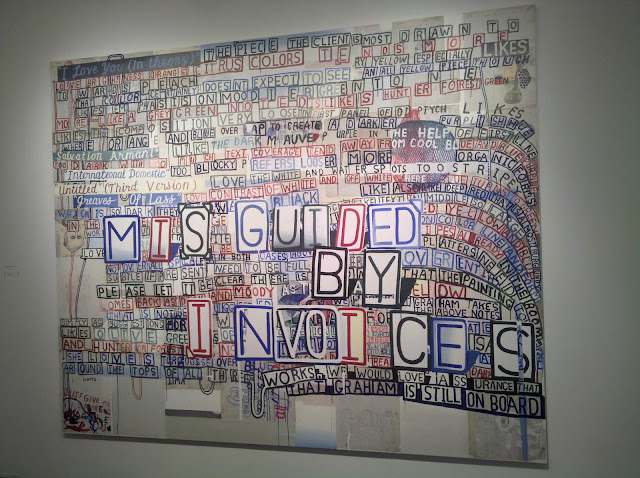
Hey, another one I thought I knew too well to forget and now I feel like I'm cheating them.
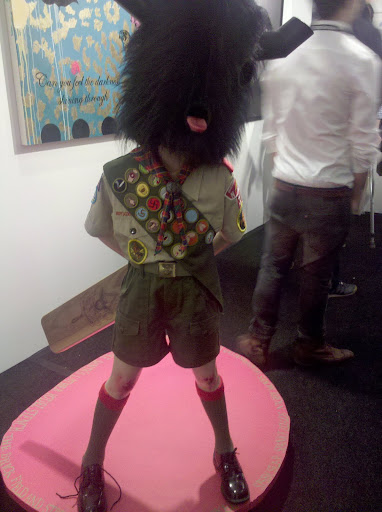

Bad boy scout making noises.
Next post: Verge
It turned out an hour was enough to go through the whole thing, though. The gallerists were friendlier but unlike its Miami incarnation this one did not provide free food and drink. Given the freebie culture of NYC calorie constraint was wise - there probably wouldn't be enough security personnel even with well-behaved informed crowds.
That's part of the sense I get of New York art conventions and fairs as consisting much more of people doing business than art tourists. Art tourism is a theme of a lot of the art, but in this city, that theme is a commodity rather than metacommentary.

Are you imagining this? Doesn't it taste great? David Stein's absurd books, at Eleanor Harwood from SFO, give me an opportunity to mention the weirdness of SCOPE's corporate identity, and the political paradoxes of art. People's Revolution, Kelly Cutron's PR and Marketing firm, arranged SCOPE's VIP list and opening reception. There are multiple reality shows involving these people.
The entangling of leftist politics into the corporate intentions of a field about and for the rich is morally dizzying. The deliberate imagery of appropriation, the complications of the extraordinary inequality created by an abundance of artists of all different qualities of ignorance, layered into multiple generations of terrifying people and movements and strategies, is enough to make me wonder where I even got the principles I seem to have, and how best to shut them up so I can think about this more like the emergent poly-consciousness it has already become.

Hey, another one I thought I knew too well to forget and now I feel like I'm cheating them.


Bad boy scout making noises.
Next post: Verge
Thursday, March 04, 2010
Armory Show
Everything I shot from Wednesday to Sunday is here
I registered as press in advance for this and showed up about ten minutes after the press conference to pick up my badge. I briefly glanced at Pier 92, where they only show dead artists, or at least which consists primarily of resale by historical, museum-level galleries. While there's much more interest in the first market of Pier 94, the historical gap is small.
Example:

Juan Genoves, Transcurso, 2006 detail. From the press balcony this looked like a photograph but it's really thick impasto.
As press, I have exchanged my attention and goodwill for privileged access, and operate as free publicity for the show. But as a cultural consumer advocate in the attention economy, I now consider anyone non-VIP who pays for access to be a Sucker. If you have a blog or anything I recommend you write yourself an assignment letter or just register on their site and get in free.
Maybe my research-fu is weak but I cannot find an image of how the pier is laid out. It's basically a T. I started on the right arm of the T and methodically went down the rows. Because there are an odd number of rows on the staff of the T you can end up redundantly walking along it this way (and thereby seeing the featured Berlin part twice), so it's best to do the arms by row and the pier over the water in a zig zag with a little overlap in the middle. It's easy to get distracted by something on the other side and overwalk. With the white lights and walls everywhere, my eyes got much tireder than my feet. One thing I found I ended up doing was lingering in a corner staring at a piece I found completely uninteresting, just to rest.
I felt I was coming into this one with preferences different from ones I would have other years or even other days. Some of my arbitrary rules, and why:
1. Galleries that are basically retail shops for pop art stars (Hirst, for example) aren't worth discussing.
2. I'm sick of contempt for the audience and easy cultural critique. True, just because the economy's down doesn't mean artists should make collector-friendly work, but conceptual laziness just means you have nothing intellectually complex to talk about. It looks like some idiot has scammed the gallery and that's just business.
3. I'm paying particular attention to class issues as well as ethnic politics. While the Armory is aggressively post- and inter-national, it began as an American exodus for the European avante-garde. Without contemporaneity entrenched in the Obama Era we're just looking at aesthetic balloons.
4. Things that are difficult to transport or install are interesting. Animatronics, performances, digital media.
5. But contrary to (4), things obviously marketed towards a particular part of the market - either museums or collectors - aren't as interesting as those that really work just for the Armory. It's like admiring mall displays. I'm looking for what is essentially intimate public art without the effects of public funding.
6. Every year I am less and less inclined to like something just because it resembles my own field, figurative painting. There's a lot of figurative painting that's done either photographically or non-representationally that is to be considered more as conceptual.
7. Things that would appeal to people with no art background and anything that disregards the whole modernist project hold a certain fascination, if only because I find myself so willing to dismiss them. This also goes for "bourgeouis" or "kitsch" work aimed at a theoretical market solely about interior decorating. Many critics overlook this work because it's boring, and it does take up the bulk of the show, but it's the sanctuary for the many many artists who just want to make beauty. Escapism is practical.
8. I like computers and science. And environmental issues. Grids, numbers, language: these are things I look at because they're not something I can do well. HOWEVER. I am, if not a dogmatic technophile, at least an anti-Luddite, and will dismiss anything that's simply critical of technology/modernity/"synthetic".
9. Unless it's something new by a favorite, I'm not looking at things I've seen before, either at Basel or at last year's Armory. There are actually repeat pieces, which looks like it would be embarrassing or at least appears lazy. It could be argued that the galleries are standing behind their investments but it's a waste of time to a spectator.
10. I am not looking at other art blogs and I am trying to see things other art blogs don't before I read them.
Ultimately it's just what caught my eye, which has an average sort of attention bandwidth, and VIKI's camera.
What struck me in particular yesterday was the sort of economy simplified by postcolonialist Ngugi as the rich stealing from the rich. Or rather, most galleries are investments by rich people who consider themselves smart enough to try to find the few stupid rich people, or to catch the rich in moments of irrationality. Hence the free flow of champagne for handpicked VIPs. I can barely speculate on what percentage of art sales are gallery to gallery. At the super blue chip level there's little to firmly connect particular artists to particular galleries besides geography, and even that's irrelevent when the fairs, especially in an art hub like NYC, consist of the fattest international ambassadors.
Lets look at pretty pictures now.
Okay, Ian Davis does these awesome wide-angle landscapes full of identical figures, commentaries on industrial science, but I can't find the new ones he had up and the picture didn't come through. Look out for "hubris" and "skeptics".
I ran into Jack Tilton, and had a look at Roberts & Tilton, his L.A. branch, which had some Kehinde Wiley (who may have stepped on me) and Titus Kaphar, who deconstructs canvases to comment on race history:

"Nip tuck" (or "Lillian Dandridge"?), 2009, Crumpled canvas oil painting.

Markus Schinwald, Carola, 2009. 22x18cm oil on canvas. 19th century style portraits of cyborgs are a good direction (and many were made in the 19th century already)
Also at Yvon Lambert was one of those "difficult to reproduce" near-conceptual museum pieces by Zilvinas Kempinas, Serpentine, consisting of magnetic tape blown in a corner by a fan.

This is interesting because apart from context it's illustration or at least kind of gross pedophiliac erotic art. It reminds me of Gravity's Rainbow a bit. I apparently didn't photo the attribution - if you know it, say it.
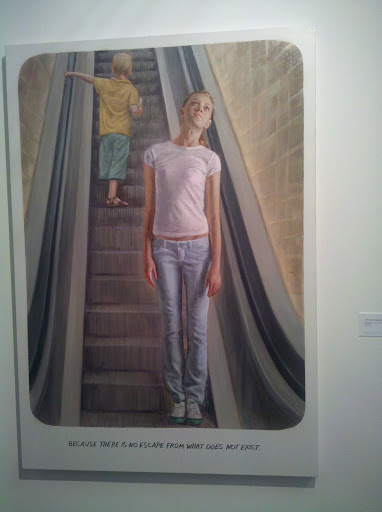
Muntean/Rosenblum: another of these paintings entrenched in photography, but there's something about the children/escalator imagery and the discouragement of connection between photo and caption that has a poetic kick for me.
You know what? Because I've been just taking photos of labels (when they were there, because they weren't always) to attribute, I may as well use those. Let's try that.


It is a photo of a moon landing with the astronauts made black.
No, that method doesn't really work.
The galleries that featured shows of individual artists seemed to be very proud of doing this - it was something they could afford to do, selflessly. It definitely paid off in attention to have an immersive, consistent space. A prime example is Adam McEwan's "I Am Curious Yellow" installation at Nicole Klagsburn, which consisted of a series in only white and yellow, including blowups of Soviet German buttons, swastikas, and large prints of an article about an Olympic runner's alleged gender fraud.
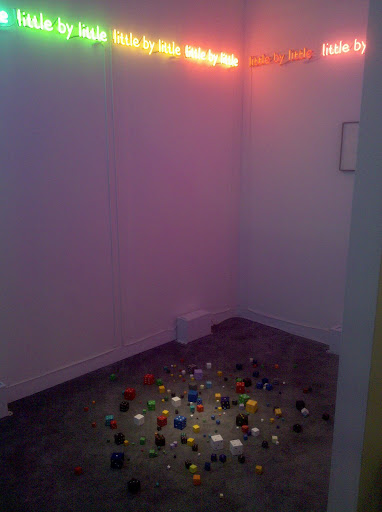
Peter Liversidge got a bright little room with two installations ("Come On In" of handpainted dice, and "little by little" neon) including the proposals for those installations.
The preponderance of high-hung neon was nicely deflated by a Japanese artist's smashed neon sign near the ground.
I always like what Mizuma has, but if there's a message to take from this show it's that Orientalism doesn't even work any more.
my bandwidth was shutting down in protest and I started favoring one-liners. I chatted with the Andrew Kreps assistant working under this for a few minutes. Kreps also featured a pro-choice piece by Andrea Bowers, consisting of a pre-Roe v. Wade letter from a shudderingly oppressed woman who had no idea where to get an abortion to a sympathetic (or maybe not) organization.
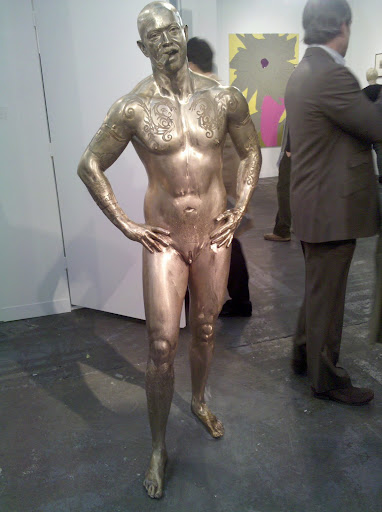
English mega-gallery White Cube featured this life-size bronze of a trans man by Marc Quinn.

What I find interesting about Benjamin Edwards ("Solo", 2010 and already sold) is that 3-d is already, especially if done right, far beyond the glitchy emptiness he foregrounds.
Limning the differences between him and Justin Faunce is a quick exercise.
SCHNELL.

I love David Schnell very much.
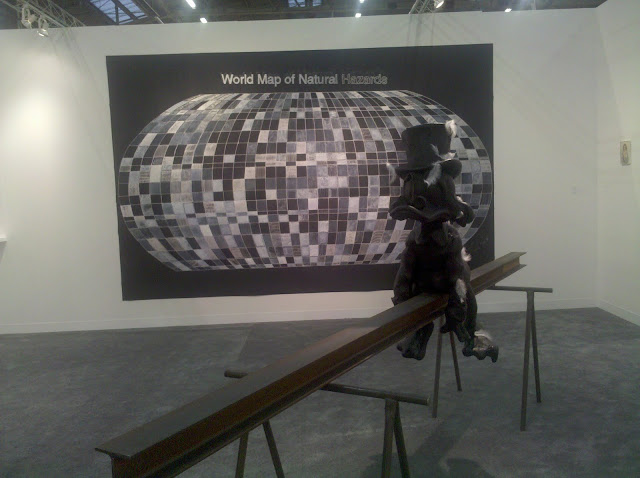
I wonder if the title "world map of genreal hazards" is intentional. I rather like "genreal" better than "general". I don't know who did the Scrooge McDuck but it's excellently posed for this photo op.

South African galleries felt especially strong this year. This taxidermied farcegory had a live band playing incidental music that I saw VIPs covering their ears for.

Mathias Faldbakken, I think. It's bare canvas, pencil, kinda sloppy. What I'm seeing is a conceptual artist without assistants.

I took a picture of one of my favorite artists and completely just assumed I'd remember her name.
![]()
RM Fischer is an example of why I like sculpture more than anything these days. It's eclectic and interesting and playful and doesn't care quite as much about The Market.
I think that's about all I can salvage. I don't want to declare a judgment on the show overall, because it's a lot of different galleries trying a lot of different tactics, and sometimes the good parts are just good and the bad parts are really interesting. I'll do further posts on the many other venues that have sprouted up this week. There are qualitative comparisons to be made, and I'd rather not debate context or content.
Oh yeah. I nearly forgot the Forget perfume booth. They had spray, for forgetting. It didn't work.
I registered as press in advance for this and showed up about ten minutes after the press conference to pick up my badge. I briefly glanced at Pier 92, where they only show dead artists, or at least which consists primarily of resale by historical, museum-level galleries. While there's much more interest in the first market of Pier 94, the historical gap is small.
Example:

Juan Genoves, Transcurso, 2006 detail. From the press balcony this looked like a photograph but it's really thick impasto.
As press, I have exchanged my attention and goodwill for privileged access, and operate as free publicity for the show. But as a cultural consumer advocate in the attention economy, I now consider anyone non-VIP who pays for access to be a Sucker. If you have a blog or anything I recommend you write yourself an assignment letter or just register on their site and get in free.
Maybe my research-fu is weak but I cannot find an image of how the pier is laid out. It's basically a T. I started on the right arm of the T and methodically went down the rows. Because there are an odd number of rows on the staff of the T you can end up redundantly walking along it this way (and thereby seeing the featured Berlin part twice), so it's best to do the arms by row and the pier over the water in a zig zag with a little overlap in the middle. It's easy to get distracted by something on the other side and overwalk. With the white lights and walls everywhere, my eyes got much tireder than my feet. One thing I found I ended up doing was lingering in a corner staring at a piece I found completely uninteresting, just to rest.
I felt I was coming into this one with preferences different from ones I would have other years or even other days. Some of my arbitrary rules, and why:
1. Galleries that are basically retail shops for pop art stars (Hirst, for example) aren't worth discussing.
2. I'm sick of contempt for the audience and easy cultural critique. True, just because the economy's down doesn't mean artists should make collector-friendly work, but conceptual laziness just means you have nothing intellectually complex to talk about. It looks like some idiot has scammed the gallery and that's just business.
3. I'm paying particular attention to class issues as well as ethnic politics. While the Armory is aggressively post- and inter-national, it began as an American exodus for the European avante-garde. Without contemporaneity entrenched in the Obama Era we're just looking at aesthetic balloons.
4. Things that are difficult to transport or install are interesting. Animatronics, performances, digital media.
5. But contrary to (4), things obviously marketed towards a particular part of the market - either museums or collectors - aren't as interesting as those that really work just for the Armory. It's like admiring mall displays. I'm looking for what is essentially intimate public art without the effects of public funding.
6. Every year I am less and less inclined to like something just because it resembles my own field, figurative painting. There's a lot of figurative painting that's done either photographically or non-representationally that is to be considered more as conceptual.
7. Things that would appeal to people with no art background and anything that disregards the whole modernist project hold a certain fascination, if only because I find myself so willing to dismiss them. This also goes for "bourgeouis" or "kitsch" work aimed at a theoretical market solely about interior decorating. Many critics overlook this work because it's boring, and it does take up the bulk of the show, but it's the sanctuary for the many many artists who just want to make beauty. Escapism is practical.
8. I like computers and science. And environmental issues. Grids, numbers, language: these are things I look at because they're not something I can do well. HOWEVER. I am, if not a dogmatic technophile, at least an anti-Luddite, and will dismiss anything that's simply critical of technology/modernity/"synthetic".
9. Unless it's something new by a favorite, I'm not looking at things I've seen before, either at Basel or at last year's Armory. There are actually repeat pieces, which looks like it would be embarrassing or at least appears lazy. It could be argued that the galleries are standing behind their investments but it's a waste of time to a spectator.
10. I am not looking at other art blogs and I am trying to see things other art blogs don't before I read them.
Ultimately it's just what caught my eye, which has an average sort of attention bandwidth, and VIKI's camera.
What struck me in particular yesterday was the sort of economy simplified by postcolonialist Ngugi as the rich stealing from the rich. Or rather, most galleries are investments by rich people who consider themselves smart enough to try to find the few stupid rich people, or to catch the rich in moments of irrationality. Hence the free flow of champagne for handpicked VIPs. I can barely speculate on what percentage of art sales are gallery to gallery. At the super blue chip level there's little to firmly connect particular artists to particular galleries besides geography, and even that's irrelevent when the fairs, especially in an art hub like NYC, consist of the fattest international ambassadors.
Lets look at pretty pictures now.
Okay, Ian Davis does these awesome wide-angle landscapes full of identical figures, commentaries on industrial science, but I can't find the new ones he had up and the picture didn't come through. Look out for "hubris" and "skeptics".
I ran into Jack Tilton, and had a look at Roberts & Tilton, his L.A. branch, which had some Kehinde Wiley (who may have stepped on me) and Titus Kaphar, who deconstructs canvases to comment on race history:

"Nip tuck" (or "Lillian Dandridge"?), 2009, Crumpled canvas oil painting.

Markus Schinwald, Carola, 2009. 22x18cm oil on canvas. 19th century style portraits of cyborgs are a good direction (and many were made in the 19th century already)
Also at Yvon Lambert was one of those "difficult to reproduce" near-conceptual museum pieces by Zilvinas Kempinas, Serpentine, consisting of magnetic tape blown in a corner by a fan.

This is interesting because apart from context it's illustration or at least kind of gross pedophiliac erotic art. It reminds me of Gravity's Rainbow a bit. I apparently didn't photo the attribution - if you know it, say it.

Muntean/Rosenblum: another of these paintings entrenched in photography, but there's something about the children/escalator imagery and the discouragement of connection between photo and caption that has a poetic kick for me.
You know what? Because I've been just taking photos of labels (when they were there, because they weren't always) to attribute, I may as well use those. Let's try that.


It is a photo of a moon landing with the astronauts made black.
No, that method doesn't really work.
The galleries that featured shows of individual artists seemed to be very proud of doing this - it was something they could afford to do, selflessly. It definitely paid off in attention to have an immersive, consistent space. A prime example is Adam McEwan's "I Am Curious Yellow" installation at Nicole Klagsburn, which consisted of a series in only white and yellow, including blowups of Soviet German buttons, swastikas, and large prints of an article about an Olympic runner's alleged gender fraud.

Peter Liversidge got a bright little room with two installations ("Come On In" of handpainted dice, and "little by little" neon) including the proposals for those installations.
The preponderance of high-hung neon was nicely deflated by a Japanese artist's smashed neon sign near the ground.
I always like what Mizuma has, but if there's a message to take from this show it's that Orientalism doesn't even work any more.
my bandwidth was shutting down in protest and I started favoring one-liners. I chatted with the Andrew Kreps assistant working under this for a few minutes. Kreps also featured a pro-choice piece by Andrea Bowers, consisting of a pre-Roe v. Wade letter from a shudderingly oppressed woman who had no idea where to get an abortion to a sympathetic (or maybe not) organization.

English mega-gallery White Cube featured this life-size bronze of a trans man by Marc Quinn.

What I find interesting about Benjamin Edwards ("Solo", 2010 and already sold) is that 3-d is already, especially if done right, far beyond the glitchy emptiness he foregrounds.
Limning the differences between him and Justin Faunce is a quick exercise.
SCHNELL.

I love David Schnell very much.

I wonder if the title "world map of genreal hazards" is intentional. I rather like "genreal" better than "general". I don't know who did the Scrooge McDuck but it's excellently posed for this photo op.

South African galleries felt especially strong this year. This taxidermied farcegory had a live band playing incidental music that I saw VIPs covering their ears for.

Mathias Faldbakken, I think. It's bare canvas, pencil, kinda sloppy. What I'm seeing is a conceptual artist without assistants.

I took a picture of one of my favorite artists and completely just assumed I'd remember her name.
RM Fischer is an example of why I like sculpture more than anything these days. It's eclectic and interesting and playful and doesn't care quite as much about The Market.
I think that's about all I can salvage. I don't want to declare a judgment on the show overall, because it's a lot of different galleries trying a lot of different tactics, and sometimes the good parts are just good and the bad parts are really interesting. I'll do further posts on the many other venues that have sprouted up this week. There are qualitative comparisons to be made, and I'd rather not debate context or content.
Oh yeah. I nearly forgot the Forget perfume booth. They had spray, for forgetting. It didn't work.
Subscribe to:
Posts (Atom)